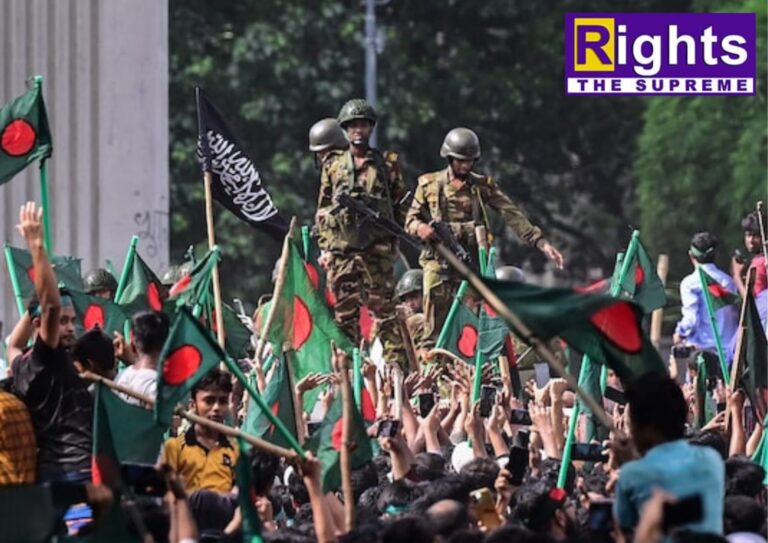Political Crisis in Bangladesh
INTRODUCTION
In 2022, while the whole world was crippling with the after effects of the Covid-19 pandemic, Bangladesh was slowly on its path to economic upliftment. Many economists had predicted Bangladesh to reach great heights in the international society, but the turn of events that took place in the past few months will hamper this possibility. While the Internatinal Monetary Fund projected the Global Economy to grow at 3.6 percent both in 2022 and 2023, Bangladesh’s economy was consistently growing over a decade. Post Covid-19, the GDP growth stood at 7.25 percent in FY 2021-22, 0.05 percentage point higher than the target rate and 0.31 percentage point higher than the previous fiscal year. The per capita national income stood respectively at US$ 2,723 and US$ 2,824 in FY 2021-22 compared to US$ 2,462 and US$ 2,591 respectively in FY 2020-21.
Until 2018, Bangladesh had a reservation system that allowed the descendants of the 1971 Freedom movement to enjoy a 30% quota in Civil Services and Public sector employment. However, due the students protest in 2018, this reservation was withdrawn by the government.
Sheikh Hasina had been the Prime Minister of Bangladesh for the past fifteen years, and she secured fourth term as the Prime minister of Bangladesh, as the party Awami League and its allies wins elections, by winning 225 of 300 parliamentary seats contested. The main opposition Bangladesh Nationalist Party boycotted the polls, calling it a big sham. Official figures suggested that the voter’s turnout was very low, with just 40%, in comparison the last election in 2018 had a voter turnout of more than 80%. But despite all the allegations, Sheikh Hasina and the Awami League had formed the government.
HIGH COURT RULING AND HOW THE PROTESTS STARTED
In June 2024, the High Court reinstated a rule that reserves nearly one-third (30%) of posts for the descendants of those who participated in the country’s 1971 liberation movement. Under the job-quota system, 56% of government job positions in Bangladesh were reserved for various groups, including 30% for the descendants of freedom fighters who fought in the 1971 War of Independence. As a result of this, the students from various universities organized themselves and commenced the protests. The protests turned violent as they clashed with police and members of Bangladesh Chhatra League, a student wing of Prime Minister Sheikh Hasina’s governing Awami League party. Soon the protests turned violent as, Bangladesh's street began to erupt with political violence, students staged walkouts from universities and disrupted roads and railway lines, there were also various clashes with the police.
The protests were further provoked and fueled when Sheikh Hasina, in her speech, likened the protesters with the “Razakars”, a derogatory term which was used to refer to those who helped Pakistani troops during the Liberation War. In July, some 200 people were killed, mostly protesters, in clashes. The Government had to shout down schools and universities across the country. Soon the PM announced for a judicial probe into the killings, but the protesters denied all these and continued to demand for PM’s resignation. The government declares a curfew with a shoot-on-sight order.
SUPREME COURT RULING, A WIN FOR THE PROTESTERS
On July 21, Bangladesh Supreme Court rules against the reinstatement of the job quota and scaled back the quota system setting the reservation cap for the descendants of freedom fighters at 5%. This was to be considered as a huge win for the protestors, but the protests did not stop and they kept demanding the PM to resign from the office. Later, The UN, Amnesty International, US and Canada appeal for peace and an end on government crackdown on protests.
On August 1, the Bangladesh government officially banned Jamaat-e-Islami and its student wing, Chhatra Shibir, designating them as terrorist organizations under the Anti-Terrorism Act. This further increased the violent clashes and the overall death toll from clashes in Bangladesh has rose to at least 300 people, after 94 died in the deadliest day in weeks of anti-government demonstrations. The protests intesified and the leaders called for a “Final Protest.”
THE END OF HASINA'S REIGN
The protesters entered the PM’s residence and PM Sheikh hasina had to resign and flee out of the country for her safety. Sheikh Hasina flew to India inorder to escape. In India, her plane landed at the Hindon Air base, and the ousted PM met NSA Ajit Doval. Thus ended the fifteen year long reign of Sheikh Hasina.
Bangladesh Army Chief, Waqar Uz Zaman made a television appearance and declared that the Army will form a caretaker government for Bangladesh. President Shahabuddin dissolves the Parliament and BNP chairperson Khaled Zia is freed. The protestors demanded a caretaker government be formed with Nobel Peace Laureate Mohammad Yunus as its Chief Advisor.

